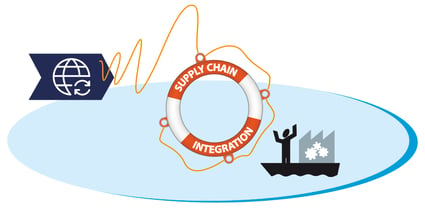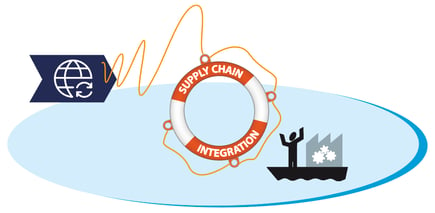How Supply Chain Integration Helps Production Planners
Jesse Kelber - October 10, 2019

 Consumer financial technology has reached a tipping point where pretty much everything you need to do on a regular basis can be done electronically. You can pay the rent, make a car payment, and even lend your friend $20 all from the convenience of an app on your smartphone. Then there’s that one payment, you know the one, when you have to dig around in your desk drawer to find your checkbook. At its core, supply chain integration does for you, the production planner, what eliminating the checkbook does for the general population, speeds up transactions and allows every relevant stakeholder access to the information they need. It’s about enabling your entire end-to-end supply chain to interact and interconnect via Industry 4.0 technologies. Because no matter how much of that tech you have deployed internally, if your supplier is still presenting you with a handwritten invoice—well, it just doesn’t add up.
Consumer financial technology has reached a tipping point where pretty much everything you need to do on a regular basis can be done electronically. You can pay the rent, make a car payment, and even lend your friend $20 all from the convenience of an app on your smartphone. Then there’s that one payment, you know the one, when you have to dig around in your desk drawer to find your checkbook. At its core, supply chain integration does for you, the production planner, what eliminating the checkbook does for the general population, speeds up transactions and allows every relevant stakeholder access to the information they need. It’s about enabling your entire end-to-end supply chain to interact and interconnect via Industry 4.0 technologies. Because no matter how much of that tech you have deployed internally, if your supplier is still presenting you with a handwritten invoice—well, it just doesn’t add up.
End-to-End Visibility Is the Goal: Integration Is the Path
As with the majority of Industry 4.0 solutions, the goal of supply chain integration is end-to-end visibility. Starting with how much raw material to order and which supplier can get it to you on time, through production load balancing and inventory management, and finally through logistics and delivery to the end customer. Throughout the chain, there are many, many steps and stages where something can get lost in the shuffle. By integrating your systems with your suppliers’ systems and your logistics infrastructure, you’re making progress toward that goal of complete transparency. Each Excel spreadsheet you can eliminate and replace with data in a central repository gets you one step closer to your visibility goals. And each partner you can get on board by digitizing their data stream will simplify the process even further.
Information Silos Kill Productivity
As a production planner, you’re right in the middle of the supply chain and deal, daily, with all that that entails. You have to work with materials suppliers, shop floor managers, production equipment, warehouse workers, and logistics planners. Sometimes simultaneously. What happens when you run into a piece of data you can’t access? Or worse, what happens when you plan your run only to find out that a key detail was missing entirely from your information? These information silos are one of the primary reasons that working toward a fully integrated supply chain should be a high priority. The time and money lost when you have to rework an entire production run, just because someone forgot to tell you something, can be catastrophic to your bottom line. An integrated supply chain, with complete end-to-end visibility and a central data repository is the solution to improving ROI and kicking your production up a level or two.
Balance is Key: Incoming Supplies, Inventory, and Outgoing Orders
Total supply chain integration may be the ultimate goal, but getting there will be an iterative process. No matter how far your company is on your own digital transformation journey, you’re going to be held up by suppliers not keeping pace, or logistics planning still being conducted on the back of envelopes. This goes in reverse as well, you may be just starting your own journey, while one of your primary suppliers may be fully digitized and getting impatient with your need for paper invoices. Balance is key, make sure you’re able to interface with your key partners on their terms whenever possible, then work on extending your transformation to other key areas of the business. For example, if your logistics partners are already using RFID and GPS to track shipments, be sure your warehouse is able to accommodate them by installing the sensors on your outgoing shipments and that your IT is able to handle the data being sent back from this leg of the value chain.
Real-Time is the Real Deal
IoT sensors on your production floor, RFID tags on incoming supplies and outgoing orders, AI-powered advanced analytics, and the underlying infrastructure to run it all is all about one thing—real-time data. When you need to plan your next production run while a run is still in progress, what better way to know what’s working and what isn’t than to have a constant stream of up-to-the-minute data coming in to analyze? And the advanced analytics behind that analysis is what allows for the incredibly accurate demand forecasting and planning you’re now able to produce. And once you have the run planned and underway, data coming in from logistics can help your logistics planners adjust and pivot on the go, allowing you to know what adjustments you need to make to your next run.
Production Line Flexibility Enables Supply Chain Flexibility
Being in the middle of the chain, production is in the unique position of being able to affect both the up- and down-stream sides of the supply chain. The more flexibility you are able to build into your factory floor, manufacturing equipment, and warehousing infrastructure, the better able to adjust to the demands from both ends of the chain. Have a delayed shipment of supplies? No problem, you can adjust that run to tomorrow and use existing supplies to turn out tomorrow’s run today. And this type of flexibility is what Industry 4.0 and the integrated supply chain is all about. That delayed shipment? You only found out about that because the supplier is digital and their trucks literally sent you an alert when they got held up by a storm.
More Data Enables Better Data
All the data being produced by all of this technology is going into that central repository. From there, advanced analytics are poring over every last byte and churning out more accurate demand forecasts than you’ve ever seen. These forecasts, in turn, allow you to tweak your production runs, adjust your logistics, and in the end become more efficient than ever before. And that new efficiency leads to better data being sent to the repository for analysis, and the cycle continues with more and more accurate and more efficient results every time. Each new workflow provides its own set of new data. And each set is in turn analyzed and incorporated into the next workflow iteration.
When all is said and done, the bottom line here is that everything is relative. Each of these benefits is related to each of the others, and in turn to each up- and down-stream step of the supply chain. That means the full benefit can only be fully realized when each step of the supply chain is integrated with each of its other surrounding steps. Making iterative progress by upgrading your production line with appropriate Industry 4.0 technologies is the first, and most important step a production planner can take to begin the journey toward a fully integrated supply chain.
LATEST POSTS
- Understand Circular Economy in The Manufacturing Industry
- How Can Industry 4.0 IT Integration Be Achieved Smoothly?
- The Significance of Order Sequencing in Discrete Manufacturing
- How to improve your Supply Chain Management: The Power of Control Towers
- Optimizing Human Resource Scheduling in Manufacturing: A Technological Approach


